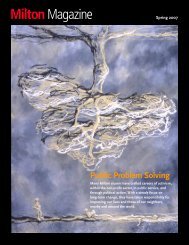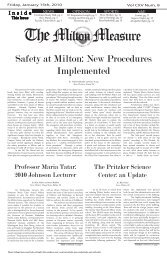Milton Magazine - Milton Academy
Milton Magazine - Milton Academy
Milton Magazine - Milton Academy
- No tags were found...
Create successful ePaper yourself
Turn your PDF publications into a flip-book with our unique Google optimized e-Paper software.
Faculty PerspectiveThe Ruth King Theatre in KellnerForever grateful for the shared enterprise of exposing our common humanityTwenty years ago an acre of lawnstretched between <strong>Milton</strong>’s healthcenter and the library. Those of uswho came to the campus to interview forthe position of theatre teacher and directorthat year saw blueprints for the new performingarts facility which was to rise fromthat empty plot. It was to be an impressivebuilding with two theatres, a large sceneshop, a beautiful dance studio and ampleroom for orchestra, chorus, jazz and thespeech program. That empty expanse ofgrass fairly danced with potential.It is, of course, reasonable and sensible tothink of buildings as mere aggregationsof brick and glass and mortar. For the betterpart of a year, as we watched Kellnerrise from the earth, it was fascinating tosee those pieces come together. From thevery beginning it was clear that the buildinghad an inner sanctum, a space at thecenter which was set apart. I think we didnot know at that time what the theatrewould be called, but Ruth King’s namesakespace was taking its distinctive form inbrick and steel day by day before our eyes,shaped by its purpose. A concrete platform.A large, open space set deep into thefoundation and surrounded by walls risingto the top of the building. Even the mostcasual observer could not fail to recognizethe form as either a theatre or a place ofworship.Theatres and temples are, after all, notreally very different. In most of the greatcultures of the world the theatre was bornand nurtured in places of worship. Butwhile sacred architecture customarily soarsin spires, cupolas, steeples or minarets,theatres more often sweep downwardto the performance space. The majesticsemicircle of the seats at the Theatreof Dionysus, the tiered balconies of theopera house and the intimate galleries ofthe Globe all direct the eye downward tothe stage—the compelling focal point foran entire audience caught up together inlaughter or tears or a single, shared gaspof recognition. And now at <strong>Milton</strong> the gallerieswere rising around a performancespace. Though it was still only bricks, mortarand steel, it would soon be much more.In the meantime, in Wigg Hall and Room1212 and the boys gymnasium we actedand made music and built scenery anddanced, but we knew that soon the seatswould be in place and the curtains wouldbe hung and the new theatre would cometo life.Some buildings do remain aggregationsof brick and glass and mortar, but anyonewho has walked onto an empty stage thathas been in use for more than a few yearsknows that theatres are made of muchmore. Ruth King Theatre, 17 years after itopened, is a rich concoction of memory,old paint, echoes, sweat and the first subtleintimations of next year’s musical. In avery real way it is now a creation of allof those who have played upon its stage,brought up a light on cue, or risen fromone of those red upholstered chairs inspontaneous applause. Costumes that havebeen worn in a dozen different productionsform unseen connections betweenactors or dancers of different eras whohave never met one another. Layer uponlayer of color on the stage floor forms<strong>Milton</strong> <strong>Magazine</strong> 53
















